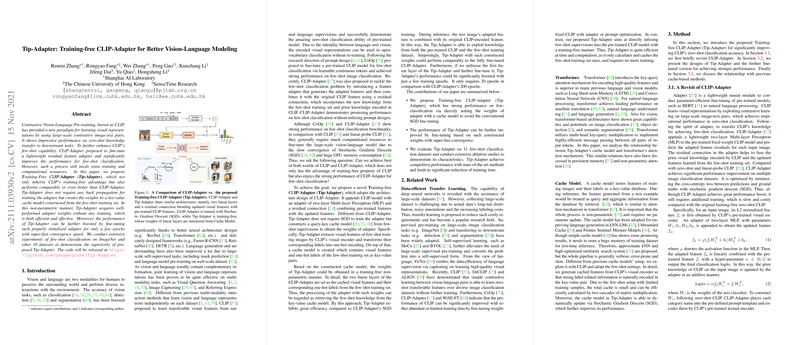Tip-Adapter: Advancements in Training-Free Vision-LLMing
The paper presents Tip-Adapter, a novel approach to enhancing the capabilities of Contrastive Vision-Language Pre-training, specifically CLIP (Contrastive Language-Image Pre-training), without the need for additional training. By leveraging Tip-Adapter, the authors aim to preserve the training-free nature of CLIP while achieving competitive performance compared to traditional, training-intensive methodologies like CLIP-Adapter.
Background and Motivation
CLIP has demonstrated impressive zero-shot performance by utilizing contrastive learning on extensive image-text pair datasets. However, its few-shot learning performance leaves room for improvement. CLIP-Adapter improved this by incorporating a lightweight feature adapter that required additional training, thereby reintroducing computational demands. Tip-Adapter is developed to address this, maintaining a training-free setup while providing competitive, if not superior, performance in few-shot learning scenarios.
Methodology
Tip-Adapter employs a non-parametric approach by converting a key-value cache model from few-shot training data into adapter weights. This method involves:
- Feature Extraction: Using the CLIP visual encoder to map images to visual features, while transforming labels into one-hot vectors.
- Cache Construction: Treating features as keys and labels as values, constructing a cache model without backpropagation or gradient updates.
- Adapter Integration: This cache is then used to initialize the weights of a two-layer MLP within the adapter, enabling immediate deployment without training fine-tuning.
This design ensures that Tip-Adapter remains computationally efficient while still enhancing CLIP's baseline performance by utilizing few-shot data effectively.
Results and Analysis
The results, evaluated across 11 datasets including ImageNet, underscore the efficacy of Tip-Adapter. Notably, the performance of Tip-Adapter is comparable to CLIP-Adapter under few-shot conditions, often surpassing other state-of-the-art methods like CoOp and linear-probe CLIP, especially with fewer shots:
- On ImageNet, Tip-Adapter achieves substantial performance gains over zero-shot CLIP, showing improvements of 1.70% with zero additional epochs compared to CLIP-Adapter's 200.
- Across the remaining datasets, Tip-Adapter consistently exhibits superiority over zero-shot implementations, and when further fine-tuned (Tip-Adapter-F), it achieves the highest accuracy amongst compared systems.
Implications and Future Work
The implications of Tip-Adapter are significant in resource-constrained environments, where training budget and computational resources are limited. The non-parametric nature and efficiency gains offer a practical solution for implementing high-performance few-shot learning without the overhead of training extensive models.
Looking forward, further enhancements could explore the optimization of adapter weight construction methods or expanding the non-parametric models' applicability to broader, multimodal tasks. Extensions could include exploring dynamic cache updates or incorporating larger pre-trained models, providing even deeper integration into multimodal tasks.
This paper positions Tip-Adapter as a compelling intersection of efficiency and performance in vision-LLMing, setting the stage for broader applications and innovations in AI with minimal computational burden.
